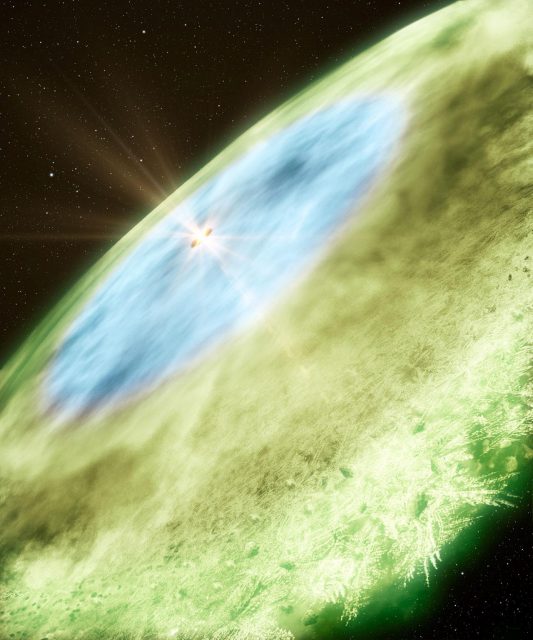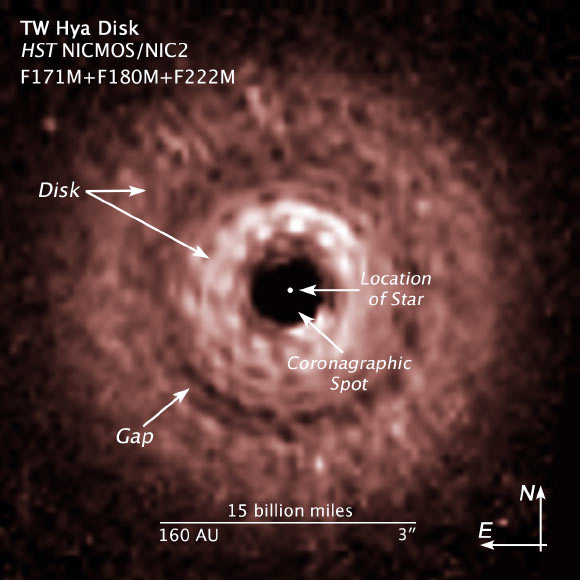Tracing snow lines around new born suns

TW Hydrae is a peculiar star. Although it is not bright enough to be visible to the unaided eye, it is relatively close to us, just 180 light-years away, and this makes it the closest T Tauri star in the sky. A T Tauri star is a solar system being born, they are still to enter into what astrophysicists call the main sequence, or the adult life of a star, marked by the beginning of hydrogen fusion in the star’s core. T Tauri stars, instead, get the energy from the gravitational collapse of the primordial hydrogen cloud. Most of them have circumstellar disks prone to lead to planetary formation. In fact, these stars were initially identified due to their brightness variability and infrared emission produced by the combination of no hydrogen fussion and extended disks around them.
So in many senses, TW Hydrae is like our own Sun before it was born as a star. And this includes the potential surrounding planetary system. Since most of the phenomena associated with planetary formation take place in spatial scales impossible to be resolved at distant stars it is obvious that having such a target in the sky is very appealing. Most of the details are only possible to discern using the most advanced telescopes to observe the closest star systems. In this case, a work by Qi, Öberg and collaborators was able to image a very particular region of the protoplanetary disk around TW Hydrae using the ALMA observatory 1.
ALMA is a millimeter and sub-millimeter interferometer composed by 66 antennas located in the privileged location of Chajnantor plateau (Chile), some 5,000 km above sea level. As they can be moved around the plateau, those antennas provide multiple configurations for interferometry. This allows the observatory to produce the sharpest and most detailed observations up to date at the wavelengths where it works. Although the scientific commissioning started a couple of years ago, ALMA did not enter into full operation until March 2013. The results presented here are thus one of the first ground-breaking science that this Observatory will surely produce in the incoming years.
State of the art telescopes can only produce big science if they are used with the intention of touching the limits of our knowledge. Planetary formation is one of the most intriguing topics in modern astrophysics and to determine how different planets are formed at different distances from the mother star, the concept of snow line is also crucial. In short, all volatiles are able to condense when the surrounding conditions in the protoplanetary disk are adequate. Condensation of most abundant volatiles (such as H2O, CO2 or CO) probably has a profound impact on the way particle grows to form planets. This happens because it increases the mass surface density for planetary accretion but also because this “snow” is usually stickier, making particle growth more efficient. In the solar nebula, it is commonly accepted that the water snow line developed at about 3 AU influencing the birth of Jupiter and Saturn. Farther out at some tens of AUs, CO and other volatiles also condensed and helped to form the most distant bodies in our planetary system, maybe from Uranus and Neptune to Trans-Neptunian Objects and comets.
The CO snow line had been already seen around star HD163296 using directly submillimeter interferometric observations. This time, Qi and collaborators followed a different way, using a tracer to determine the abundance of CO around the forming star. This tracer was N2H+, which in the presence of CO is normally destroyed by transferring a proton to the CO molecule but, in absence of CO, the N2H+ destruction is much slower. This idea, together with the previously unavailable capabilities of ALMA, made it possible to image the snow line of CO around a star like TW Hydrae, as shown in Figure 2. In order to properly locate the CO snowline, a model of the distribution of the CO and N2H+ was also required. This should be in agreement with other observations of this and other protoplanetary disks as also demonstrated by Qi et al., who were able to locate the snow line at 28-31 AU from the star, at 3-sigma confidence.

As I said in the beginning TW Hydrae, being so close and distinctive, is a popular star. A few weeks ago, another work by Debes and colaborators 2 published in the Astrophysical Journal showed the presence of a gap in the protoplanetary disk (see Figure 3) by using the Hubble Space Telescope in the near infrared using coronographic techniques. The gap was found to be located at some 80 AUs from the center. There are a number of possible explanations for such a gap in the mass distribution around a developing star but, obviously, the presence of a planet is the most intriguing one. Should this gap be explained by a planet, it would have a mass between 6 and 28 times the Earth’s mass, Debes et al. said. Such a planet would have been influenced in this formation by the CO snow line proposed by Qi.

One of the NASA’s mottoes is “follow the water”, as the ancient explorers did in the past. Also in this research field, the discovery of the water snow line would be a major step forward to understanding the formation of planets like Jupiter and Saturn. However, this is possibly at the limit of our current abilities. Anyway, if powerful instruments like ALMA is are used with intelligence we will sooner or later find it and be able to study its properties.
References
- Qi C., Oberg K.I., Wilner D.J., d’Alessio P., Bergin E., Andrews S.M., Blake G.A., Hogerheijde M.R. & van Dishoeck E.F. Imaging of the CO Snow Line in a Solar Nebula Analog, Science, DOI: 10.1126/science.1239560 ↩
- Debes J.H., Jang-Condell H., Weinberger A.J., Roberge A. & Schneider G. (2013). THE 0.5-2.22 μm SCATTERED LIGHT SPECTRUM OF THE DISK AROUND TW Hya: DETECTION OF A PARTIALLY FILLED DISK GAP AT 80 AU, The Astrophysical Journal, 771 (1) 45. DOI: 10.1088/0004-637X/771/1/45 ↩